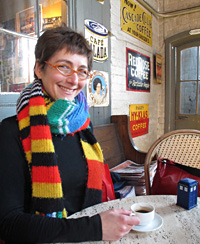As a teacher, I try not to be too prescriptive about knitting. There are lots of different ways of doing things - casting on, holding your needles, holding your yarn, increasing, and so forth. And in my opinion, if the thing looks good and doesn't fall apart, then whatever technique you used to make it is good.
I will recommend a technique if the difference if visible or structural. Finishing, for example. I'm a big proponent of
mattress stitch over
backstitch for seaming, because it
looks so much better.
I used to be fairly relaxed about casting on, but I'm starting to get more insistent. I'm a long-tailed cast on snob. There are situations in which other cast ons work better, but for most situations, the long-tailed cast on is terrific. It's quick, creates a very attractive and stable low-profile edge, and the first row of stitches are easy to work. And, big bonus for sock knitters, it's stretchy.
I'm getting tired of watching knitters struggle with the backwards loop cast on -- incredibly quick and easy, yes, but it makes a very unstable edge, and the first row is a real challenge to knit. And the knitted cast on -- which I've been known to teach myself -- has some serious weaknesses, too. The stitches are easier to work, but it's slow and the edge is fairly loopy. And to make it reasonably loose, you have to cast on over two needles, which makes it very loopy. I'm really not happy with how it looks.
I used to only teach the long-tailed cast on in my sock and mitten knitting classes, but if time permits, I tend to give a quick tutorial in all my classes. A lot of students admit to me that they tried to learn it from books or vidoes, but weren't able to get the hang of it. I'm happy to admit I had the same problem -- couldn't figure it out for the life of me from books, and it was only when Kirsten showed it to me years ago that I really got it. (Thanks, Kirsten, BTW! You have no idea how much you improved my knitting.)
It is a bit tricky, no question, and it often takes a bit of practice, but the students get it. And for the most part, they see the advantages immediately and tell me that they'll keep using it. And I go home feeling faintly smug that I've shown more knitters the one true path.
This week, I had an interesting conversation. C. attended a class of mine years ago on mitten knitting, and I had shown her the long tailed cast on. She started the project in this week's class with a knitted cast on. I asked her about the long-tailed method. She told me she thought it was "weird" and was happy with the method she'd been using all along.
Weird, I get. No argument with that. But happy with the knitted cast on? I was taken aback.
But it's much better, I said. It's faster and looks nicer.
Faster for me, sure. C. said that she found it cumbersome. She's not wrong, I had to admit.
And looks better? Actually fairly subjective. She likes the edge, particularly how it looks in ribbing.
C. had made a genuine effort to learn something new, and had decided it wasn't for her. And me, I learnt something new - that just because I think it's better for me and my knitting doesn't mean it actually is for everyone.
I'm going to keep teaching it, and explaining why think it's best, but I think I'll be more careful about feeling smug...


 and at Patternfish.
and at Patternfish.















